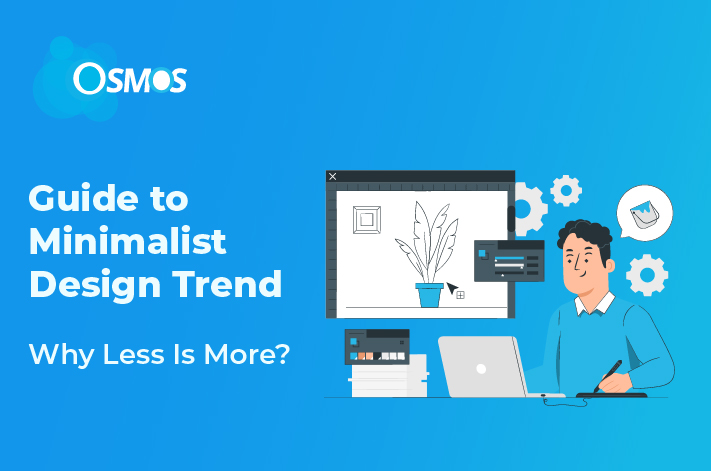TL; DR
Minimalist designing can be a vital tool for businesses as it can help streamline communication, boost brand recall, and exude professionalism.
Businesses can leave a significant impression in today’s world by making purposeful design choices. Minimalism enables them to convey their essence effectively and create lasting connections with their audience.
It’s not just a trend but a strategic approach that speaks volumes with minimal noise which makes it a valuable tool to achieve business success.
In a world filled with visual noise and information overload, the minimalist is a inspiring design trend that has become a powerful tool for businesses to make a lasting impact.
In this guide, we will explore minimalistic design and how it helps businesses succeed. So, let’s get started!
What is Minimalistic Design?
Minimalistic design is a design philosophy that emphasizes aspects such as simplicity, clarity, and removing excess elements to achieve a clean visual style. This approach focuses on functionality and an emphasis on the use of space.
Principles Of Minimalistic Design
Here are some of the key principles of minimalistic design:
- Simplicity
Minimalism aims to reduce designs to their most fundamental elements and thus, helps eliminate unnecessary decorations and features. This simplicity makes the design easy to understand.
- Use of Negative Space and Color Palette
Negative space, also known as white space, is the empty or unmarked space around and between design elements. Minimalist designs use negative space to create a sense of balance and elegance.
These designs typically use a restricted color palette which favors neutral colors like white, black, gray, or muted tones. The limited use of color also contributes to a clean and uncluttered look.
- Typography and Geometric Shapes
Minimalist typography tends to be simple and highly legible. Sans-serif fonts are commonly used, and text is often set clean and organized.
Clean lines and simple geometric shapes, such as rectangles and circles, are prevalent in minimalist design. These shapes contribute to a sense of order and balance.
- Clarity, Hierarchy, and Timelessness
Minimalist designs employ a clear visual hierarchy, with the most essential elements prominently displayed through size, color, and placement.
Minimalistic designs aim for timelessness rather than following short-lived design trends. This quality helps ensure that the design remains relevant and appealing over a long time.
Why Use Minimalist Design for Your Business?
Using minimalist design for your business can offer a range of benefits that can positively impact your brand, products, and overall success. Here’s why using minimalist design principles can be beneficial for your business:
- Clarity and Focus
The minimalist design promotes clarity by taking away unnecessary elements. This helps convey your business’s message or product offerings directly to your audience. It also ensures that your audience quickly understands what your business is all about.
- Memorability and Timelessness
Minimalist designs feature simplicity and a distinct visual identity. These qualities can make your brand and its visual assets more memorable to consumers. When people can easily recall your brand or product, it increases the chances of repeat business and recommendations.
Minimalist design tends to be timeless, as it avoids trendy elements. This longevity is essential for businesses looking for a lasting and consistent brand image.
- Improved User Experience and Professionalism
By presenting information and navigation options clean, organized, and uncluttered, users can easily find what they are looking for and interact with your digital platforms effectively.
Minimalist designs convey a sense of professionalism and sophistication. This can be particularly good for businesses operating in industries where trust, reliability, and competence are essential for success.
- Mobile Responsiveness and Faster Loading Times
With the increasing use of mobile devices for online activities, minimalist design aligns well with responsive web design principles. Minimalist layouts are easily adaptable and ensure your website and app look and function well on various screen sizes and devices.
Minimalist designs typically have fewer elements and smaller file sizes, resulting in faster loading times for websites and apps. This improved performance enhances the user experience and positively impacts your search engine ranking (SEO).
- Easier Brand Consistency
Minimalist brand assets such as logos and color schemes are easier to maintain consistently across various marketing channels and platforms. This consistency reinforces your brand identity and builds trust with your audience.
- Environmental Responsibility
The minimalist design philosophy aligns with environmental sustainability. By producing fewer printed materials and using fewer resources for design elements, your business can reduce its environmental footprint.
- Differentiation and Adaptability
A minimalist approach can help your business stand out in a crowded marketplace. While others may use flashy or cluttered designs, your minimalist aesthetic can draw attention precisely since it is distinctive and refreshing.
Minimalist design can be adapted to various brand personalities and industries. Whether your business is known for its elegance, innovation, or efficiency, minimalist design principles can be customized to suit your unique identity.
Minimalist Design Tips for Businesses
Minimalistic design can be found in various fields such as:
- Graphic design
- Web design
- Architecture
- Interior design
- Fashion
The appeal of minimalist designs is in its ability to convey a sense of sophistication, elegance, and calm. Here are some minimalist design tips for businesses:
- Start with a Clear Purpose
Defining your purpose is the first step in minimalist design. It involves understanding why you are creating a particular design element, whether it is a website, logo, or marketing collateral.
Always consider the message, emotion, or impression you want to convey to your target audience. Clearly defining your purpose helps you make design decisions that align with your goals and resonate with your audience.
- Simplify Your Branding
Your brand identity is the first point of contact between your business and potential customers. Simplifying it involves streamlining elements like your logo, color palette, and typography.
Aim for a simple and memorable logo while avoiding overly intricate or complex designs. Also, limit your color scheme to a few chosen colors that represent your brand’s essence.
- Whitespace is Your Friend
Whitespace, or negative space, is a design area that is intentionally left blank. It plays a crucial role in minimalist design by creating visual balance and focus.
Whitespace allows the viewer’s eyes to rest and helps separate and highlight key design elements. Utilize whitespace strategically to enhance the clarity and elegance of your design.
- Focus on Clarity
Creating a clear visual hierarchy ensures your audience can easily navigate and understand your content. Use design elements like font size, color, and spacing to guide the viewer’s eye and emphasize the most important information.
Establishing a clear hierarchy makes it easier for users to engage with your design and absorb your message effectively.
- Eliminate Unnecessary Elements
Every design element should serve a specific purpose and contribute to the overall message. Identify and remove elements that do not improve the user’s understanding or experience, such as excessive decorations, icons, or redundant text. Less is often more in minimalist design.
- Use High-Quality Imagery:
If you include images in your design, prioritize high-quality, relevant visuals. Avoid cluttered or distracting images that are irrelevant to your message. Sometimes, a single impactful image or a well-placed graphic can convey your message more effectively than an array of visuals. Make sure to choose images that align with your brand’s style and resonate with your audience.
- Consistent Layouts
Consistency in layout design is essential for brand recognition. Maintain a cohesive look and feel across different materials and platforms, from your website to printed materials.
Consistent layouts help reinforce your brand identity and make it easily recognizable to your audience.
- Proper Color Usage
When incorporating color into your minimalist design, choose colors that evoke the desired emotions and resonate with your brand’s identity.
Avoid using too many colors, as this can confuse or overwhelm viewers. A limited color palette can create a more visually pleasing and cohesive design.
- Mobile-Friendly Design
In today’s mobile-centric world, your minimalist designs must be responsive. This means they adapt seamlessly to various screen sizes and orientations, especially on mobile phones.
Minimalist design principles can enhance the user experience on smaller screens by reducing clutter and emphasizing only essential elements.
- Usability and Functionality
Minimalism should not sacrifice usability. Whether you’re designing a website, app, or physical product, prioritize functionality and user-friendliness. Ensure that your design effectively serves its intended purpose and allows users to easily accomplish their goals.
- Test and Iterate
Testing your minimalist designs with real users and collecting feedback is crucial in the design process. Use this feedback to make improvements and refine your designs further. Continual iteration helps ensure that your designs align with your business objectives and meet user needs effectively.
- Environmental Considerations
In physical spaces, consider the environmental impact of your minimalist designs. Use sustainable materials, minimize waste, and design with long-term sustainability in mind.
Incorporating eco-friendly practices into your design processes can align with your brand’s social and environmental responsibility commitment.
- Brand Consistency
Maintaining a consistent minimalist design approach across all your branding materials is essential for building a strong brand identity.
Ensure that your design elements, including typography, color schemes, and overall aesthetics, remain consistent from your website to your business cards. Consistency helps reinforce brand recognition and trust.
- Tell a Story
Minimalism can be a powerful tool for storytelling. Use minimalist design to distill and communicate a compelling narrative about your brand or product.
Simplifying complex messages into a minimalist design can make them more memorable, and emotionally resonant with your audience.







